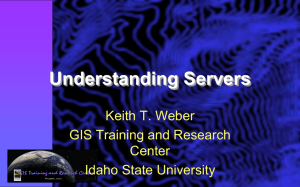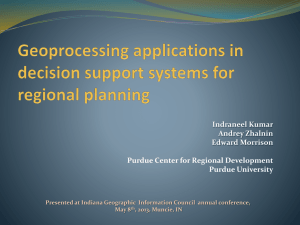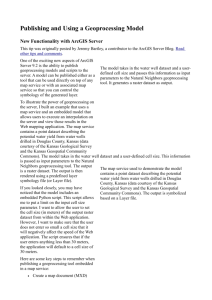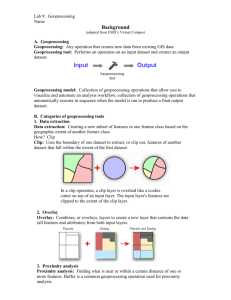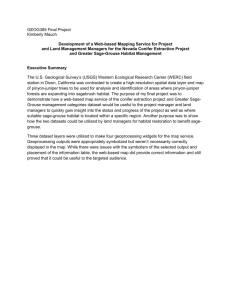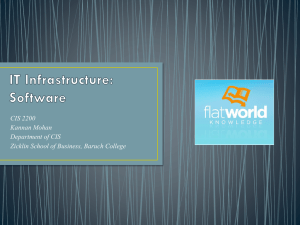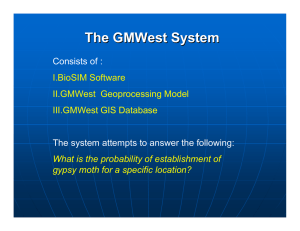PAY-PER-USE REVENUE MODELS FOR GEOPROCESSING SERVICES IN THE CLOUD
advertisement
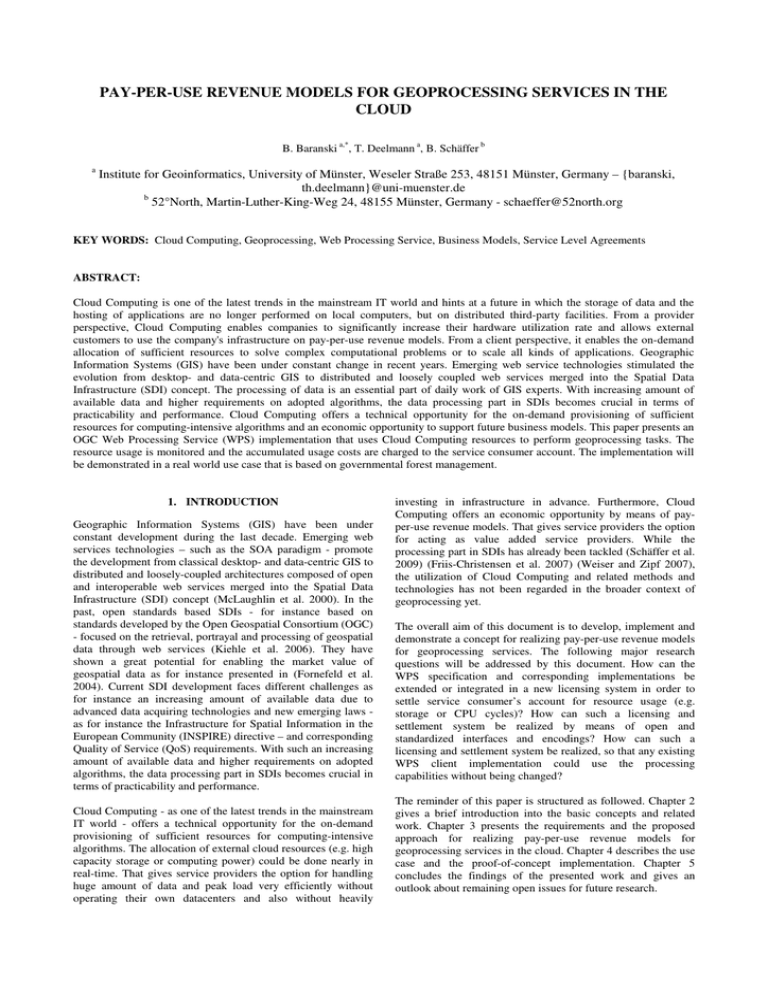
PAY-PER-USE REVENUE MODELS FOR GEOPROCESSING SERVICES IN THE
CLOUD
B. Baranski a,*, T. Deelmann a, B. Schäffer b
a
Institute for Geoinformatics, University of Münster, Weseler Straße 253, 48151 Münster, Germany – {baranski,
th.deelmann}@uni-muenster.de
b
52°North, Martin-Luther-King-Weg 24, 48155 Münster, Germany - schaeffer@52north.org
KEY WORDS: Cloud Computing, Geoprocessing, Web Processing Service, Business Models, Service Level Agreements
ABSTRACT:
Cloud Computing is one of the latest trends in the mainstream IT world and hints at a future in which the storage of data and the
hosting of applications are no longer performed on local computers, but on distributed third-party facilities. From a provider
perspective, Cloud Computing enables companies to significantly increase their hardware utilization rate and allows external
customers to use the company's infrastructure on pay-per-use revenue models. From a client perspective, it enables the on-demand
allocation of sufficient resources to solve complex computational problems or to scale all kinds of applications. Geographic
Information Systems (GIS) have been under constant change in recent years. Emerging web service technologies stimulated the
evolution from desktop- and data-centric GIS to distributed and loosely coupled web services merged into the Spatial Data
Infrastructure (SDI) concept. The processing of data is an essential part of daily work of GIS experts. With increasing amount of
available data and higher requirements on adopted algorithms, the data processing part in SDIs becomes crucial in terms of
practicability and performance. Cloud Computing offers a technical opportunity for the on-demand provisioning of sufficient
resources for computing-intensive algorithms and an economic opportunity to support future business models. This paper presents an
OGC Web Processing Service (WPS) implementation that uses Cloud Computing resources to perform geoprocessing tasks. The
resource usage is monitored and the accumulated usage costs are charged to the service consumer account. The implementation will
be demonstrated in a real world use case that is based on governmental forest management.
1. INTRODUCTION
Geographic Information Systems (GIS) have been under
constant development during the last decade. Emerging web
services technologies – such as the SOA paradigm - promote
the development from classical desktop- and data-centric GIS to
distributed and loosely-coupled architectures composed of open
and interoperable web services merged into the Spatial Data
Infrastructure (SDI) concept (McLaughlin et al. 2000). In the
past, open standards based SDIs - for instance based on
standards developed by the Open Geospatial Consortium (OGC)
- focused on the retrieval, portrayal and processing of geospatial
data through web services (Kiehle et al. 2006). They have
shown a great potential for enabling the market value of
geospatial data as for instance presented in (Fornefeld et al.
2004). Current SDI development faces different challenges as
for instance an increasing amount of available data due to
advanced data acquiring technologies and new emerging laws as for instance the Infrastructure for Spatial Information in the
European Community (INSPIRE) directive – and corresponding
Quality of Service (QoS) requirements. With such an increasing
amount of available data and higher requirements on adopted
algorithms, the data processing part in SDIs becomes crucial in
terms of practicability and performance.
Cloud Computing - as one of the latest trends in the mainstream
IT world - offers a technical opportunity for the on-demand
provisioning of sufficient resources for computing-intensive
algorithms. The allocation of external cloud resources (e.g. high
capacity storage or computing power) could be done nearly in
real-time. That gives service providers the option for handling
huge amount of data and peak load very efficiently without
operating their own datacenters and also without heavily
investing in infrastructure in advance. Furthermore, Cloud
Computing offers an economic opportunity by means of payper-use revenue models. That gives service providers the option
for acting as value added service providers. While the
processing part in SDIs has already been tackled (Schäffer et al.
2009) (Friis-Christensen et al. 2007) (Weiser and Zipf 2007),
the utilization of Cloud Computing and related methods and
technologies has not been regarded in the broader context of
geoprocessing yet.
The overall aim of this document is to develop, implement and
demonstrate a concept for realizing pay-per-use revenue models
for geoprocessing services. The following major research
questions will be addressed by this document. How can the
WPS specification and corresponding implementations be
extended or integrated in a new licensing system in order to
settle service consumer’s account for resource usage (e.g.
storage or CPU cycles)? How can such a licensing and
settlement system be realized by means of open and
standardized interfaces and encodings? How can such a
licensing and settlement system be realized, so that any existing
WPS client implementation could use the processing
capabilities without being changed?
The reminder of this paper is structured as followed. Chapter 2
gives a brief introduction into the basic concepts and related
work. Chapter 3 presents the requirements and the proposed
approach for realizing pay-per-use revenue models for
geoprocessing services in the cloud. Chapter 4 describes the use
case and the proof-of-concept implementation. Chapter 5
concludes the findings of the presented work and gives an
outlook about remaining open issues for future research.
2. BACKGROUND
This Chapter gives a brief introduction into the basic concepts
and related work.
2.1 Web Processing Service
In the context of web-based geoprocessing, the OGC Web
Processing Service (WPS) interface specification (OGC 2007)
evolved as the de facto standard. It provides a straight-forward
approach to publish and execute geoprocesses over the web.
According to the WPS interface specification, a geoprocess is
defined as any calculation operating on spatially referenced
data. Such a process can range from a simple geometric
calculation (e.g. a simple intersect operation) to a complex
simulation process (e.g. a climate change model).
In detail, the WPS interface specification describes three
operations, which are all handled in a stateless manner. The
GetCapabilities operation is common to any type of OGC Web
Service and returns the service metadata. In case of WPS, it also
returns a brief description of the processes offered by the
specific service instance. To get more information about the
hosted processes, the WPS provides process metadata through
the DescribeProcess operation. This operation describes all
parameters, which are required to run a process. Based on this
information the client can perform the Execute operation upon
the designated process. As every OGC Web Service, the WPS
communicates through HTTP- GET and HTTP-POST based on
an OGC-specific XML-message encoding. However, the WPS
interface specification does not describe any aspect regarding
licensing as it is designed in this document.
enabling new pay-per-use business models with less upfront
investments.
2.3 Related Work
To speed up the processing of large amounts of data and
perform complex calculations, the use of Grid Computing or
related methods and technologies are a good choice for
achieving high calculation performance. Although the
application of Grid Computing is not novel to the mainstream
IT-world (Foster et al. 1998), in the context of geospatial
applications and OGC Web Services (OWS) only little research
has been conducted; see (Baranski 2008), (Lanig et al. 2008),
(Padberg et al. 2009) and (OGC 2009a).
Cloud Computing has not been regarded in the broader context
of SDIs yet. In (Schäffer et al. 2010a) a merger between SDIs
and Cloud Computing infrastructures was evaluated on a
conceptual level. In (Baranski et al. 2009) the scalability aspect
for a cloud enabled WPS implementation is challenged and
proven exemplary in the Google Cloud (Google App Engine).
In (Kim et al. 2009) the Amazon Elastic Compute Cloud (EC2)
was used to provide the high level of performance for impact
assessment studies of climate change that require considerable
amount of data.
The licensing aspect of geospatial services is partially covered
by the OGC Geospatial Digital Rights Management (GeoDRM)
Reference Model (OGC 2006). In (Schaeffer et al. 2010b) a
security enabled architecture is presented, in which
geoprocessing services can be enhanced in order to support adhoc licensing, without any prior offline negotiated licenses
being necessary between service consumer and service provider.
2.2 Cloud Computing
Cloud Computing is one of the latest trends in the mainstream
IT world (Gartner 2008) (Gartner 2009). The used cloud
metaphor represents the internet or other large networking
infrastructures. The paradigm behind the Cloud Computing
buzzword hints at a future in which the storage of data and
computations are no longer performed on local computers, but
on distributed facilities operated by third-party storage and
computational utilities (Foster 2008). The key characteristic of a
cloud is the ability to scale and provide computational power
and storage dynamically in a cost efficient and secure way over
the internet. By outtasking application and data to
computational facilities operated by third parties, clients do not
need to operate their own large-scale computational
infrastructure anymore. Thereby, existing fixed costs can be
transformed into variable costs and create a business advantage.
Furthermore, cloud resources (e.g. storage or computational
power) could be allocated nearly in real-time and applications
are able to scale automatically on-demand (e.g. in case of high
amounts of requests). This allows cloud users to handle peak
loads very efficiently without managing their own
infrastructures.
In essence, Cloud Computing is not a completely new concept.
It moreover collects a family of well known and established
methods and technologies under the umbrella of the term Cloud
Computing - for instance Software as a Service (SaaS) as a
model for software deployment and virtualization as an efficient
hosting platform (Sun Microsystems Inc. 2009). Besides, it
describes a paradigm of outsourcing applications and specific
tasks to a scalable infrastructure and therefore consequently
3. CONCEPT
A classification of potential license models and an abstract
architecture for realizing pay-per-use revenue models for
geoprocessing services is introduced in this chapter.
3.1 License Model
In the presented scenario for pay-per-use revenue models, the
service provider offers specific geoprocessing functionality to
the service consumer by hosting WPS instances (on-demand) in
the cloud. The geoprocessing service consumer has to pay the
service provider for the geoprocessing functionality usage.
Furthermore, the geoprocessing service provider has to pay the
cloud infrastructure provider for the resource usage. Therefore,
the geoprocessing service provider acts as a value added service
provider and forwards the resource usage costs (plus additional
business costs) to the service consumer.
Two different payment models could be identified. Firstly, the
geoprocessing service consumer has to pay the geoprocessing
service provider for the complete hosting of a WPS instance
with a specific set of offered processes (flatrate). The usage
costs for instance depend in that scenario on the booked up-time
of the WPS instance. Secondly, the geoprocessing service
consumer has to pay the geoprocessing provider for each single
execution of a specific process (pay-per-use). The usage costs
for instance depend in that scenario on the executed process and
the amount of input data to be processed; or for instance on the
plain used CPU time for the single process execution.
To ensure that service providers fulfil promised Quality of
Service (QoS) guarantees (such as geoprocessing service
availability or computational resource availability), normally a
formal contract between service consumers and service
providers - a Service Level Agreement (SLA) - is concluded
prior to the service consumption (Lee 2002). Two different
contract models could be identified for such a license
negotiation process. Firstly, so-called “click through” licenses
are concluded prior to each single service consumption (short
term contract). In that scenario, the geoprocessing service
consumer has to read the terms of the license prior to each
single process execution. After accepting them, he could
execute a specific process. Secondly, the service consumer
concludes a usage license for a specific period of time in
advance (long term contract). In that scenario, the
geoprocessing service consumer is able to execute processes
und the terms of a previously negotiated license without having
to accept the terms of license prior each single process
execution.
find-bind pattern now must be enhanced to with an 'agree' phase
in which both parties – the (geoprocessing) service consumer
and the (geoprocessing) service provider – agree to certain
guaranteed service qualities and corresponding service usage
costs. The publish-find-agree-bind pattern presented in
(INSPIRE 2008) and (OGC 2009b) covers rights management
in SDIs with a focus on restricting the access to SDI services.
Aspects like authentication, authorization and pricing are
covered, but service quality aspects are missing and a role
differentiation on the service consumer’s side is not available.
Furthermore, two different accounting models could be
identified independent of the payment models and independent
of the contract models. Firstly, the service consumer account is
charged after the geoprocessing functionality consumption is
finished (postpaid). The service consumer account is charged
for instance directly after a process execution is finished or for
instance on a monthly basis. Secondly, the service consumers’
account is charged in advanced (prepaid). A differentiation can
be made between an unlimited (for instance no usage costs limit
per month) or limited (for instance a monthly based upper limit
of usage costs) prepaid-scenario.
Generally, the geoprocessing service provider is free to design
the pricing models for his service offering. He could offer
different QoS level to different users for different prices. On the
one hand he could for instance create a kind of a ‘gold license’
(asking a high price) in which he guarantees high computational
power and immediate process execution. On the other hand he
could for instance create a kind of a ‘silver license’ (asking a
lower price compared to the ‘gold license’) in which he
guarantees medium computational power and only a queued
process execution (e.g. with a guaranteed process execution
start time within a specific time frame).
3.2 Publish-Find-Bind
The overall activity in SDIs is the retrieval, portrayal and
processing of geospatial data through interoperable web
services above organizational boundaries. Most SDIs implement
the popular publish-find-bind pattern that identifies three roles
that are involved in the process of service consumption: the
service provider, the service broker and the service consumer
(Massuthe, 2005). From this simple point of view, the SDI
service provider hosts the geospatial data in his own
organizational boundaries and operates the (geoprocessing)
services on his own computing facilities. But if we consider that
the data is mostly collected by other parties than the service
provider, we can identify the data provider as an additional role
in SDIs. Furthermore, the general trend in the mainstream IT
(emerged in the Cloud Computing paradigm) hints into a future
where services and data are hosted on third party
infrastructures. Therefore, we can identify a resource provider
as an additional important role in SDIs.
Since the service consumption now should be performed under
the terms of a previously negotiated license, the basic publish-
Figure 1. The popular publish-find-bind pattern is extended
with an additional agreement phases
3.3 Architecture
The presented architecture for realizing pay-per-use revenue
models for geoprocessing services is based on a common
policy-based XACML security architecture (OASIS 2000) and
it incorporates findings resulting from research conducted in
last OGC testbeds and a modified version of the OGC DRM
reference model (OGC 2007b) for the incorporation of
geoprocessing services. In (Schaeffer et al. 2010b) it is studied
how standard geoprocessing services can be enhanced in order
to support ad-hoc license agreements directly in-process,
without any prior offline negotiated agreements being necessary
between geoprocessing provider and geoprocessing user. The
presented abstract architecture extends the security-focused
policy-based architecture proofed during last OGC testbeds in
such a way to support pay-per-use revenue models for
geoprocessing services.
Three different domains could be identified in the context of
geoprocessing services – the service consumer domain, the
service provider domain and the infrastructure provider.
The service provider domain consists of a Service Provider who
offers specific geoprocessing functionality via the WPS
interface. A specific WPS instance is hidden behind License
Proxy, which acts as a Policy Enforcement Point (PEP) in the
proposed policy-based architecture. The license proxy is an
OGC-compliant proxy component which enriches the original
geoprocessing service metadata with precondition elements. In
general, preconditions publicly announce a potential service
consumer, which conditions (in our scenario licenses) must be
fulfilled before service consumption. This concept ensures
interoperability by allowing services to fulfil all required
preconditions prior to the service invocation. Furthermore, the
license proxy decides - by utilizing a Policy Decision Point
(PDP) - whether the service consumer is allowed to access the
geoprocessing service (or specific processes) under the terms of
the previously concluded license.
License Broker provides license templates for each
geoprocessing service and accepts (or rejects) licenses from the
service consumer (the negotiation process is realized through
the proposed license client). If a license offer is accepted, the
license broker stores the license at a License Manager. The
license manager allows the service consumer and the service
provider to check the status of concluded licenses.
The Infrastructure Provider (in our case a Cloud Computing
provider such as Amazon) offers potentially unlimited
computational resources (e.g. virtual machines). These
computational resources could be allocated on-demand by the
geoprocessing service provider to handle the geoprocessing
tasks and typically the service provider has to pay only for real
resource usage (no fixed costs). The service provider needs a
Resource Scheduler, which manages the required computational
resources. The resource scheduler automatically allocates new
resources (e.g. in times of high request rates) and frees
previously allocated resources (e.g in idle times) at the
infrastructure provider. On the one hand, the resource scheduler
has to allocate sufficient resources at the infrastructure provider
to realize an adequate Quality of Service (QoS) for the service
consumer (for example a service availability or a maximum
computation time). On the other hand, the resource scheduler
has to minimize the accumulated infrastructure usage costs for
the service provider.
In addition to the license enforcement functionality, the license
proxy component (which acts as a PEP in the policy-based
architecture) now utilizes the resource scheduler in order to
allocate sufficient computational resources at the infrastructure
provider according to the previously concluded license of the
geoprocessing service consumer.
Furthermore, a Payment Service is required to accumulate the
usage costs of the geoprocessing service consumers according
to the concluded licenses and according to the delivered QoS.
In some cases, the geoprocessing service provider has to pay
some license penalty fees if he failed to deliver the promised
service quality goals (if such penalty fees are part of the
previously negotiated contract). The payment service also
realizes or initiates the accounting (the charging of the
geoprocessing service consumer account).
4. DEMONSTRATION
Figure 2. The required components for realizing pay-per-use
revenue models for geoprocessing services
The service consumer domain consists of the Service Consumer
who interacts with a Geoprocessing Client to access the
Geoprocessing Service. Since the geoprocessing service is
hidden behind a proxy component (which restricts the service
access to service consumers who previously concluded a
license), the service consumer domain contains also a (web- or
desktop-based) License Client which enriches the original
geoprocessing client with license negotiation capabilities. A
Geographic Information Systems (GIS) and their functionalities
already play an important role in the context of forest
management. The focus here is typically on inventory and
planning, as well as in the production of detailed forest maps.
For the forest managers various issues arise. Which areas of the
forest belong to which forestry category? What is the shortest
path from an arbitrary place in the forest to the next main road?
What about the ownership of specific areas? What about the
protection of specific areas against harvesting? The following
example describes a real-world scenario which benefits largely
from Cloud Computing. It illustrates the presented ideas and
acts as a proof-of-concept.
To ensure the efficient transport of harvested wood, a forest
manager wants to calculate the shortest and safest route from
the harvesting area through the forest to the nearest main street.
A fully functional desktop-based GIS seems to be too oversized
(as well as too expensive) for this single purpose. Furthermore,
specifically developed expert software for the forestry economy
typically contains too much functionality and such software also
seems to be too expensive in acquisition and maintenance since
it is not in daily use. An OGC-compliant WPS offering route
planning processes for forested terrain that could be booked and
used on-demand based on pay-per-use payment model seems to
be an appropriate and cost-efficient tool for forest managers in
such situations.
Figure 3. The web-based license client enables users to book a
geoprocessing service instances for a specific period of time
The proof-of-concept implementation is based on the open
source 52°North WPS implementation and the security and
licensing components developed at the 52°North Security &
GeoRM Community. The security components generally enable
business and access control process for geospatial services and
spatial data infrastructures. They have been extended in order to
support the allocation of resources in the Amazon Cloud
(Amazon EC2) and to initiate the accounting process. The
proof-of-concept implementation utilized multiple mainstream
IT standards. The OASIS eXtensible Access Control Markup
Language (XACML) describes a basic security architecture,
protocol and license encoding, which serves as the foundation
for the presented concepts. This was combined with OASIS’
Security Assertion Markup Language as a common encoding
for security tokens. On the message level, the OASIS
WS-Security (WSS) describes a secure message exchange that
is used on a technical level to transport security and license
tokens, encrypt and sign message. This specification is
accompanied by WS-Trust for managing trust and WS-Policy
for the encoding of preconditions.
5. CONCLUSION
This Chapter concludes the findings of the presented work and
gives an outlook about still remaining open issues for future
research.
This document describes an abstract architecture for the
seamless realization of pay-per-use revenue models for
geoprocessing services. Different licensing and accounting
models are described and could be realized with the proposed
abstract architecture. The presented abstract architecture covers
the complete license negotiation process between geoprocessing
service consumers and geoprocessing service providers.
Geoprocessing service consumers are now able to find adequate
geoprocessing service providers according to functional (for
instance offered processes) or non-functional (for instance
offered QoS guarantees and corresponding pricing models)
service requirements. With the presented architecture,
geoprocessing service providers are now able to manage the
underlying infrastructure in an efficient manner by utilizing
external Cloud Computing resources. In addition,
Geoprocessing service providers are now easily able to act as
value added service providers by forwarding their infrastructure
costs directly to the service consumers. Even though the
presented architecture is mostly technology independent (an
abstract architecture containing a description of required
components and communication), an implementation could be
realized with common web services technologies (for instance
XACML as a license encoding and WS-Policy for promoting
the license preconditions). The presented architecture is not
only limited to geoprocessing services but could also be
extended (by modifying the license encoding and the PEP
mechanisms) in such a way to support other geospatial services
(for instance for data delivery).
The commercial dimension of the presented approach presents a
basis for sustainable SDI business models. The billion Euro
market of classical GIS desktop software can thereby be merged
with SDI concepts. By incorporating Cloud Computing
technologies, we move towards a world where geoprocessing
functionality is ubiquitously available like electrical power from
the power outlet. Further research needs to be conducted on this
topic. Especially the merger of public and private clouds
towards hybrid clouds is interesting in this context. Questions
like “When does it make sense to go into a public cloud” needs
to be answered. Selective outsourcing in such hybrid clouds,
where only less sensitive georesources is transferred to public
clouds are also of high interest.
REFERENCES
Baranski, B. (2008). Grid Computing Enabled Web Processing
Service. In E. Pebesma, M. Bishr, & T. Bartoschek (Eds.),
Proceedings of the 6th Geographic Information Days, IfGI
prints (Vol. 32, pp. 243-256). Presented at the GI-days 2008,
Muenster, Germany: Institute for Geoinformatics.
Baranski, B., Schäffer, B. and Redweik, R. (2009).
Geoprocessing in the Clouds. Presented at Free and Open
Source Software for Geospatial Conference. Sydney, Australia
Fornefeld, M., Oefinger, P. and Rausch, U. (2003). The market
for geospatial information: potentials for employment,
innovation and value addes. MICUS Management Consulting
GmbH. Düsseldorf, Germany
Foster, I, Kesselman,C (1998) The Grid: A Blueprint for a New
Computing Infrastructure. Morgan Kaufmann Publishers.
Foster, I., Zhao, Y., Raicu, I., and Lu, S. (2008). Cloud
computing and grid computing 360-degree compared. In 2008
Grid Computing Environments Workshop. IEEE
Friis-Christensen A, Ostlander N, Lutz M, Bernard L (2007)
Designing Service Architectures for Distributed Geoprocessing:
Challenges and Future Directions Transactions in GIS,
Blackwell Publishing, 11: 799-818
Gartner (2008) Gartner Says Cloud Computing Will Be As
Influential As E-business. Gartner Press Release. [Online]
Available http://www.gartner.com/it/page.jsp?id=707508
Gartner (2009a) Gartner Says Cloud Application Infrastructure
Technologies Need Seven Years To Mature. Gartner Press
Release.
[Online].
Available:
http://www.gartner.com/it/page.jsp?id=871113
Hafner, M., and Breu, R. (2009). Security engineering for
service-oriented architectures. Springer. Berlin, Germany
INSPIRE (2008). Network Services Architecture, Version 3.0.
Network Services Drafting Team
Kanneganti, R., and Chodavarapu, P. (2008). SOA security.
Greenwich, Conn.: Manning
Kiehle, C., Greve, K. and Heier, C. (2006). Standardized
Geoprocessing – Taking spatial data infrastructures one step
further. Proceedings of 9th AGILE International Conference on
Geographic Information Science
Kwang Soo Kim, Doug MacKenzie (2009). Download files for
Use of Cloud computing in impact assessment of climate
change. Geoprocessing in the Clouds. Presented at Free and
Open Source Software for Geospatial Conference. Sydney,
Australia
Lanig, S., Schilling, A., Stollberg, B., & Zipf, A. (2008).
Towards Standards-based Processing of Digital Elevation
Models for Grid Computing through Web Processing Service
(WPS). In ICCSA, Lecture Notes in Computer Science (Vol.
5073, pp. 191-203). Presented at the Computational Science
and Its Applications - ICCSA 2008, Perugia, Italy: Springer
Verlag.
Lee, J. and Ben-Natan, R. (2002). Integrating Service Level
Agreements: Optimizing Your OSS for SLA Delivery. John
Wiley & Sons, Inc., New York, NY, USA
Massuthe, P., Reisig, W. and Schmidt, K. (2005). An Operating
Guideline Approach to the SOA. Annals of Mathematics,
Computing & Teleinformatics
McLaughlin, J. and Groot, R. (2000). Geospatial data
infrastructure: concepts, cases and good practice. Oxford:
University Press
OASIS 2000. eXtensible Access Control Markup Language
(XACML)
Available:
http://docs.oasis-open.org/xacml/2.0/XACML-2.0OS-NORMATIVE.zip
OGC (2006). GeoRM ReferenceModel. OGC 06-004r3
OGC (2007). OpenGIS Web Processing Service (1.0.0). OGC
05-007r7.
OGC (2009a). OWS-6 WPS Grid
Engineering Report. OGC 09-041r3
Processing
Profile
OGC (2009b). OpenGIS GeoRM Role Model. OGC 09-123
Padberg, A. and Kiehle, C. (2009): Spatial Data Infrastructures
and Grid Computing: the GDI-Grid project. Geophysical
Research Abstracts 11 (EGU2009-4242)
Sun Microsystems Inc. (2009) Cloud Computing at a higher
level.
[Online]
Available:
https://slx.sun.com/files/Cloud_Computing_Brochure_2009.pdf
Schäffer B, Baranski B, Foerster T, Brauner J (2009) A ServiceOriented Framework for Realtime and Distributed
Geoprocessing, International Opensource Geospatial Research
Symposium, 2009
Schaeffer, B., Baranski, B. and Foerster, T. (2010a). Towards
Spatial Data Infrastructures in the Clouds. In Proceedings of
13th AGILE International Conference on Geographic
Information Science, Guimarães, Portugal
Schaeffer, B., Baranski, B. and Foerster, T. (2010b). Licensing
OGC Geoprocessing Services as a foundation for commercial
use in SDIs. Presented at Second International Conference on
Advanced Geographic Information Systems, Applications, and
Services (GEOProcessing), St. Maarten, Netherlands Antilles
Weiser A, Zipf A (2007) Web Service Orchestration (WSO) of
OGC Web Services (OWS) for Disaster Management. In: Li J,
Zlatanova S, Fabbri A (ed) Lecture Notes in Geoinformation
and Cartography:239–254 Springer, New York
